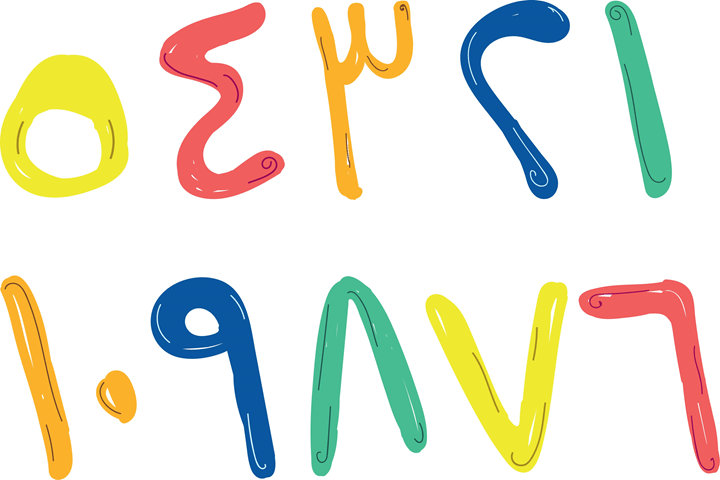Like a lot of people who study, well, any language really, we sometimes forget that grammar is about more than just words and punctuation. As learners of Arabic, we also have to remember that Arabic numbers also have grammar rules of their own. However, the good news is that they’re as easy as 1-2-3 to learn.
Three is a Magic Number
There are three main sets of rules when it comes to using numbers in Arabic grammar. However, along with these are subsets of other rules that we’ll also include here:
1. The Rules for the Numbers 3-10
(Note: We start at 3 because for the numbers 1 and 2, the counted noun either takes the singular or dual form.)
For the numbers 3 to 10, the number is written in words (not figures) and the opposite gender to that of the singular form of the counted noun.
When the number and counted noun are in an إِضافَة/’idhaafah/ addition, the counted noun is plural and in the genitive case.
Examples:
ثلاثُ سَيّاراتٍ
/thalaathu sayyaaraatin/
three cars
أَربَعُ بَناتٍ
/’arbaʻu banaatin/
four girls
عَشرُ ساعاتٍ
/ʻashru saaʻaatin/
ten hours
2. The Rules for the Numbers 11-99
For the numbers 11-99, we write the number in figures as opposed to words. However, I’ll write them out in the examples so that the grammar is clear.
With this category of numbers, the counted noun is always singular and in the accusative case.
However, the gender of the number in relation to the gender of the counted noun differs. However, this is where the subset of rules comes in.
Numbers 11-19
For 11, 12, and all of the “teen” numbers, the number is the same gender as the counted noun, as in:
اثنَتا عَشرَةَ مُعَلِّمَةً
/ithnataa ʻashrata muʻalimatan/
12 (female) teachers
أَحَدَ عَشرَ عاماً
/ʼaHada ʻashra ʻaaman/
11 years
ثَلاثَةَ عَشرَ طابِقًا
/thalaathata ʻashra Taabiqan/
13 floors
Note how, for the numbers 13-19, the two components of the number (tens and units) are opposite in gender. The gender of the ten determines the gender of the number.
Whole Tens
For the whole tens—20, 30, 40, and so on—the number is unchanging for gender
Examples:
عِشرينَ عامِلًا
/ʻishreena ʻaamilan/
20 workers
أَربَعينَ وَجبَةً
/’arbaʻeena wajbatan/
40 meals
ثَلاثونَ مِنْ رُوّادِ السِّينَما
/thalaathoona min ruwwaad issinamaa/
30 moviegoers
Note that the tens have sound masculine plural endings that vary according to case, and end in either ـونَ or ـينَ.
Compound Numbers Ending in 1 or 2
When compound numbers ending in 1 or 2, the number is the same gender as that of the counted noun:
Examples:
إِحدى وَعِشرونَ وَرَقَةَ لَعِبٍ
/’iHdaa wa ʻishroona waraqata laʻibin/
21 playing cards
اثنَتانِ وَاربَعونَ مَدينَةً
/ithnataani wa arbaʻoona madeenatan/
42 cities
اثنَتانِ وَعِشرونَ سَمَكَةً
/ithnataani wa ʻishroona samakatan/
22 fish
Compound Numbers Ending in 3-9
For compound numbers ending in a unit from 3 to 9, the number is the opposite gender to that of the counted noun.
Examples:
ثَلاثٌ وَثَلاثونَ بيتزا
/thalaathun wa thalaathoona beetzaa/
33 pizzas
أَربَعٌ وَعِشرونَ ساعَةً
/’arbaʻun wa ʻishroona saaʻatan/
24 hours
سَبعٌ وَتسعونَ دَمعَةً
/sabʻun wa tisʻoona damʻatan/
97 tears
-
The Rules for Number 100+
The numbers 100 (which can either be spelled مِئَة /miʼah/ or مائَة /maaʼah/) and above are also written in figures.
Larger and more complex numbers often combine different sets of rules. For example, 3000 shelves is ثَلاثَةُ آلافِ رَفٍّ /thalaathatu ʼaalaafi raffin/ where /ʼalf/أَلف (a thousand) is the counted noun of ثلاثَةُ /thalaathatu/ (and therefore plural and مجرور), and /raffin/رَفٍّ is the counted noun of 3000 (and thus follows the rules we’ll mention below).
Whole Hundreds, Thousands, etc.
For whole hundreds, thousands, millions, and so on the counted noun is singular and مجرور because it forms an إضافة with the number.
Examples:
خَمسُمائَةَ ساعَةٍ
/khamsumaaʼata saaʻatin/
500 hours
ألفُ مرَّةٍ
/’alfu marratin/
1,000 times
مِليونُ متابِعٍ
/milyoonu mutaabiʻin/
one million followers
Compound Numbers
Finally, when we have a number above 100 that includes tens or units, we use the last two numbers to figure out which set of rules to use.
For example, for the number 48,031, we’d use the same rules as we would for the number 31; that is, the number is the same gender as the counted noun, and the counted noun is singular and منصوب.
Moreover, if we had the number 7,890,205, we’d use the set of rules for the number 5; again, that is the rule that states the number is the opposite gender to that of the counted noun, and the counted noun is plural and مجرور.
Get these rules down, and you’ll always be number one when it comes to Arabic grammar.
Speaking of numbers, we hope now you can always count on Kaleela to teach you Arabic the right way. From the ABCs and 123s of Arabic to learning how to speak a local Arabic dialect, let Kaleela help guide you through every step of your Arabic language journey. For more information on how you can download the Kaleela Arabic language app and start learning Arabic today, visit our website at kaleela.com.




